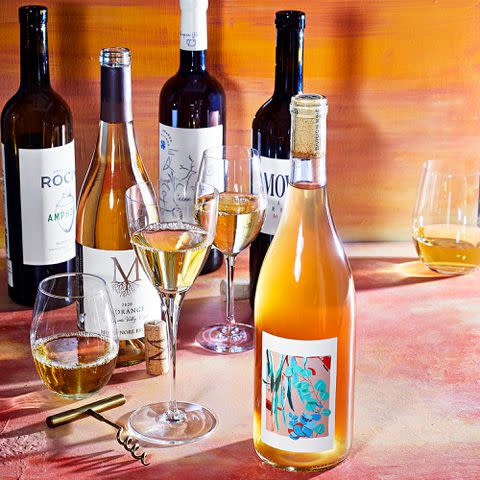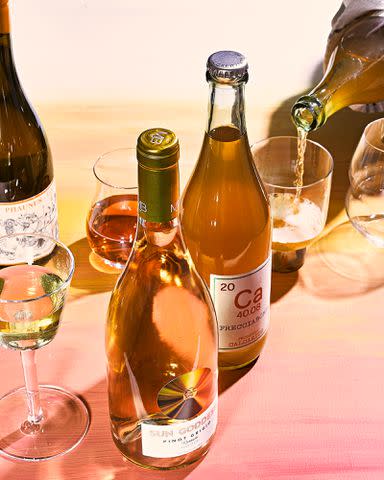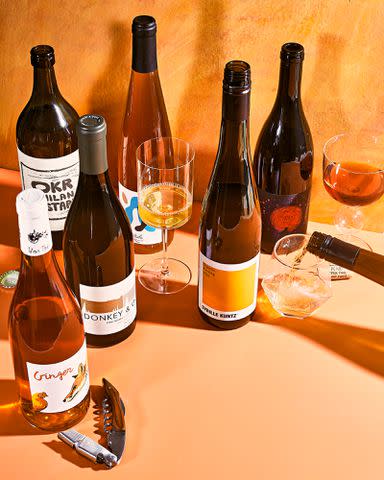The Best Orange Wines to Drink Now
Call them orange wines or skin-contact whites, either way it’s a world you need to know.
OK, first things first: There are no oranges in orange wine. And no tangerines, tangelos, mandarins, clementines, ponkans, blood oranges, or sumo citruses (citrii?) either. Not a one.
Orange wine instead is the popular way of referring to what's more technically, albeit clumsily, called "skin-contact white wine." When it comes to most wine grapes, the flesh of the grape isn't pigmented; cut a Cabernet grape open next to a Chardonnay grape, and the insides of both look more or less the same (pale green, essentially). Red wines get their color when the juice from crushed grapes is allowed to macerate on the grape-skins. White wines are typically made by crushing the grapes and then immediately removing the skins. Make a white wine the way you normally make a red wine — by keeping the juice with the skins as it ferments — and you get a wine that's anywhere from pale gold to ruddy amber to actively, inarguably orange, and which also has some of the tannins and mouthfeel of a red.

This approach is actually far, far older than making white wines without the grape skins. In the country of Georgia — where many of the best orange wines hail from — people have been fermenting white grapes on their skins for over 8,000 years, using earthenware vessels called qvevri. In the modern era, starting in the 1990s, winemakers in Italy's Friuli region, inspired by these ancient traditions, began experimenting with this approach, and now orange wines have spread to practically every winemaking region in every country. (Similarly, Friulian Pinot Grigio was traditionally made with skin contact — the style is called ramato, from the Italian word for copper.) Orange wines can be an acquired taste, but I find that if you think of orange wines as neither white nor red, but their own distinct category, they start to make more sense to a modern palate.
Of course, some sommeliers and wine experts object to the term orange wine. The more technical "skin-contact white" is far more accurate, they'll say, and point out that a lot of orange wines—shocker — aren't necessarily even orange. To that, I offer a resounding "whatever." Because, oh experts, tell me this: When was the last time you had a white wine that was actually white?

2020 Mas Théo Ginger ($25)
Rhône biodynamic vintner and polyculture farmer Laurent Clapier makes this pretty bronze-hued wine from Marsanne, Roussanne, and Grenache Blanc. It's got peppery flavors recalling ripe apricots and a grippy tannin finish.
2020 Orgo Dila-O Rkatsiteli-Mtsvane ($17)
Winemaker Gogi Dakishvili has been instrumental in the ongoing revival of Georgia's traditional qvevri-fermented, skin-contact style of winemaking. This example of his work is pale amber-orange, with citrus and stone fruit flavors; the fruit is so appealing, it's easy to overlook the wine's firm tannins.
2019 Teliani Valley Amber Blend ($18)
From Georgia, the homeland of skin contact white wines, this excellent example is a gorgeous, burnished copper in color. Made from the local grapes Rkatsiteli, Kisi, Khikhvi, and Mtsvane — there will be a quiz later — it's all mangos, pears, black tea, and earth, with firm, gripping tannins.
2020 Sun Goddess Pinot Grigio Ramato ($22)
Maybe it's a celebrity wine, sure, but hip-hop star Mary J. Blige's lightly rose-hued Pinot Grigio ramato really is very good. (Her secret weapon is Friulian winemaker Marco Fantinel.) The generous fruitiness recalls ripe nectarines, focused by a very faint edge of tannins.
2020 Herdade do Rocim Amphora Branco ($21)
Pale gold and with the distinctive scent of wildflower honey, this palate-whetting Portuguese white blend — or orange blend — offers bright acidity and tart citrus and green apple flavors. It's fermented and aged in talha, the clay amphora used in Portugal's Alentejo region since Roman times.
2020 Les Vins Pirouettes Eros by David ($23)
Deep orange in color and intensely fragrant (it reminds me of Italian chinotto sodas, a kind of spicy bitter orange scent), this is a rich, amply tannic Alsace blend of Riesling, Gewurztraminer, and Muscat from winemaker Christian Binner.
2019 Anapea Village Kvareli Kisi ($24)
Pure transparent amber in color, with earthy, citrusy, almost resinous flavors, this is an ideal introduction to traditional Georgian winemaking. It spends six months in earthenware qvevri on its skins, then an additional six months aging off the skins, with zero intervention by the winemaker as it develops.
2020 Weingut Sybille Kuntz Organic Riesling Trocken ($25)
Sybille Kuntz makes brilliant dry Rieslings from her small organic estate in Germany's Mosel River valley. Recently she also started producing this skin-contact Riesling; it's the hue of chamomile tea, with green apple and peach notes and light tannins that dance across the palate.
NV Valentina Passalacqua Progetto Calcarius Frecciabomb ($25)
Lighty fizzy, deep cloudy marmalade orange in color, tangy, chewy and tart, this Puglian pet-nat made from the Bombino grape is low in alcohol, appealingly bizarre (seriously), and lots of fun. You want conversation around the dinner table about the wine? Pour this.
2019 Vignoble de Rêveur La Vigne en Rose Sec Alsace ($25)
An unusual blend of 85% Gewurztraminer and 15% Riesling, this Alsace orange wine has unusual papaya-lychee-apricot fruit and a tannic grip that intensifies as it goes. It's quite rich, and lightly off dry; a wine for full-flavored spicy foods — a vindaloo curry, maybe, or some mouth-numbing mapo tofu.

2020 Division Winemaking Co. L'Orange ($26)
More hazy amber than actual orange, this Oregon kitchen-sink blend of Roussanne, Riesling, Chenin Blanc and other varieties frames its bright citrus and green apple fruit with toasty spice and light, appealing yeasty notes.
2020 Aphros Phaunus Loureiro ($27)
"Fragrant and [wild]" was what I wrote as I tasted this very natural-leaning orange wine. Pale hazy gold, made in clay amphora "without electricity" from the Portuguese Loureiro grape, and given six months of skin contact, it isn't a beginner orange bottle but it is undeniably compelling in its floral, lemony, grassy, energetic way.
2019 Gönc Harvest Moon ($30)
Such a gorgeous color, the rose-tinted amber of this Slovenian skin-contact Pinot Grigio — you'd be lucky to find a sunset as beautiful. It's lightly bitter (in a good, savory way) with tangy citrus and fragrant honey notes.
2020 Milan Nestarec Okr ($34)
Milan Nestarec started making wine in Czechoslovakia when he was just 16, and has gone on to become a star of the natural wine world. This amber blend of Chardonnay, Gruner Veltliner, and other grapes is crisp, earthy, and tangerine-scented.
2020 Deovlet Wines This Time Tomorrow Pinot Grigio Ramato ($35)
Winemaker Ryan Deovlet makes his home in the new San Luis Obispo coast appellation, making excellent Pinot Noirs and Chardonnay, as well as this sunset-hued, earthy but also citrusy Pinot Grigio.
2020 Domaine Loberger Horizon Gewürztraminer ($35)
Deep orange in color, exotically floral, and full of tropical flavors recalling lychees, pineapple, and mango, this Alsace wine is unabashed in its flamboyance, and also delicious. "Joyful" was the word that one taster used to describe it.
2020 Montinore Estate L'Orange ($35)
Pinot Grigio left on its skins plus a percentage of the fragrant Muscat Ottonel variety gives this pale orange wine plenty of floral, sweet citrus character, bolstered by light spiciness. If an orange wine can be a crowd-pleaser, this is it.
2019 Donkey & Goat Stone Crusher Skin Ferment Roussanne ($36)
Donkey & Goat has been at the forefront of the natural wine movement in California since it was founded in 2004. And while not all natural wines are orange, nor all orange wines natural, this one takes the best of both approaches with its dusky pear and stone fruit flavors, hazy gold hue, and tongue-coating skein of tannins.
2017 Movia Sivi Grigio Ambra ($49)
Slovenian winemaker Ales Kristancic was an early adopter of skin-contact white winemaking. (His Lunar white was a game-changer when it first appeared in the U.S. in the early 2000s.) This amber-pink Pinot Grigio recalls earthy apricots, and has a lightly tannic, palate-coating texture.
For more Food & Wine news, make sure to sign up for our newsletter!
Read the original article on Food & Wine.
